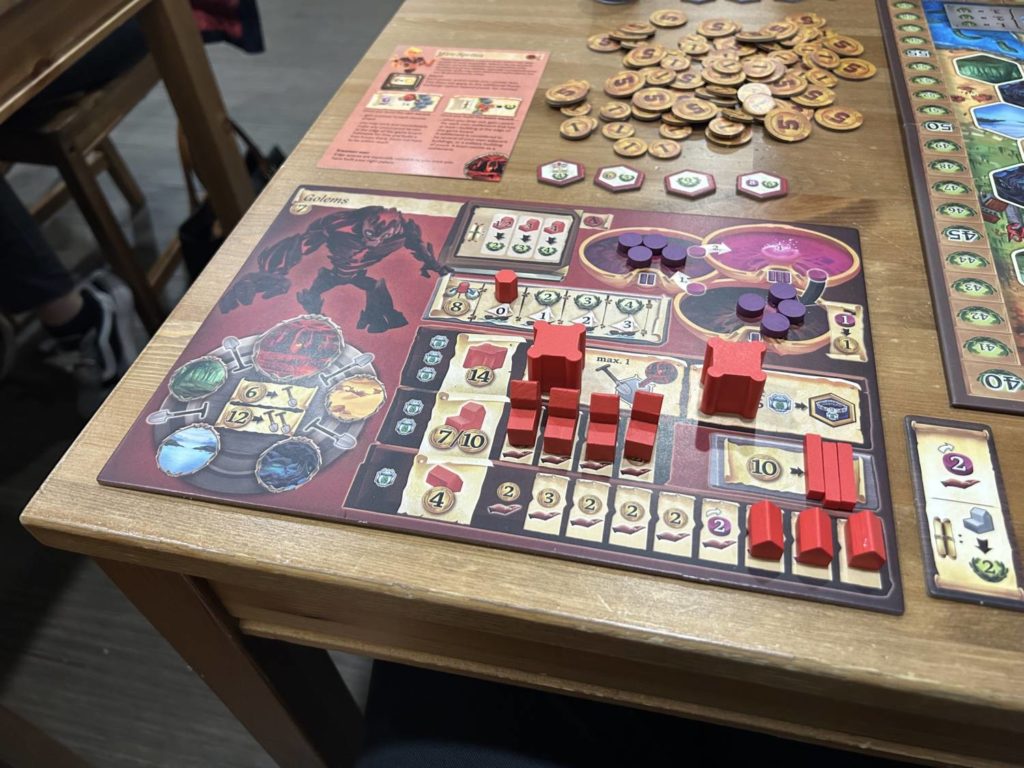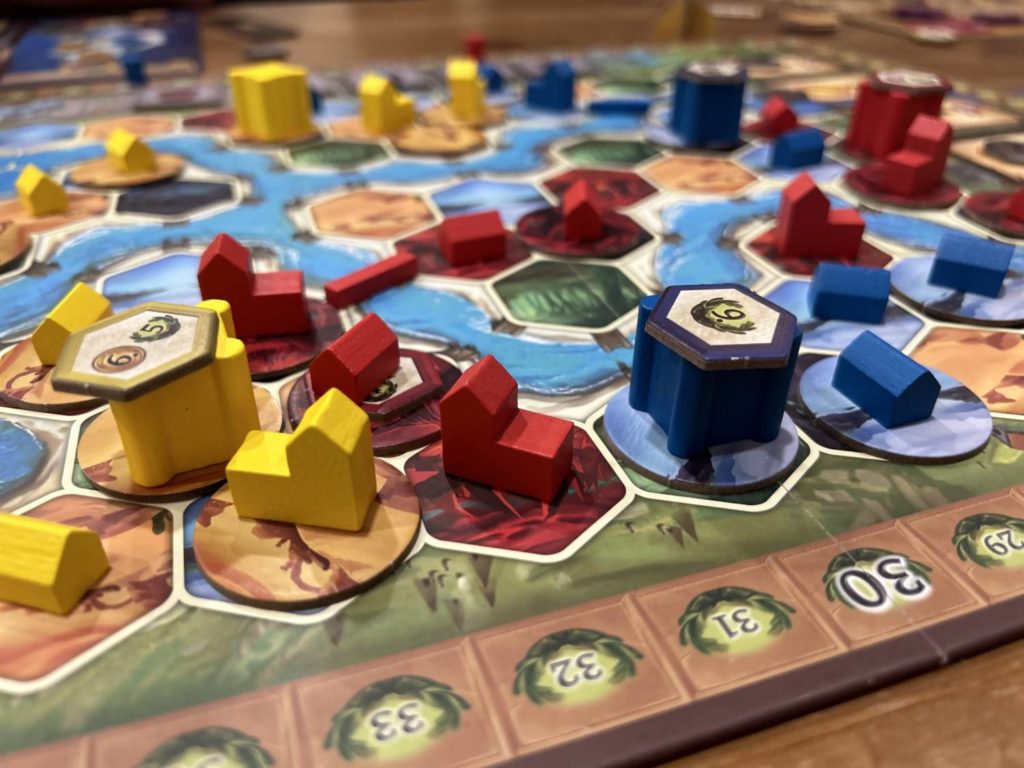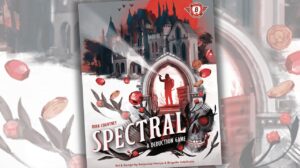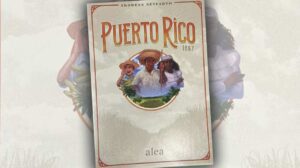Terra Mystica was the first rules-dense Euro game I ever purchased. As remains tradition, I bought it without ever having played it. My game purchases run, to this day, on vibes. While I wouldn’t call the art for Terra Mystica good, I would call it evocative, and even as a tertiary member of the board gaming community at that time, its reputation seemed obvious to me. You look at that box, and you know that at least the game itself is convinced of its greatness.
To be entirely honest, I think I was mostly drawn to the idea of buying a game that came in a box weighing as much as a 1st grader.
I remember the first time I sat down to play. It took hours. Five of them, I think. It was very late. I had never onboarded such a complex rule set before, and I certainly had nowhere near the same handle on teaching a game as I do now. I am sure, were you to show me video of that night, that I would be screaming at the monitor.
As a result of those lengthy early experiences, Terra Mystica got very good at sitting on my shelf. I busted it out again in the early days of grad school, for a single late-night game against my classmate Brooke. By the end of our first play, we sat staring at the board in mutual admiration. “It feels like there’s a lot here,” one of us said. We both felt compelled to read forums.
As it turned out, that was our only game of Terra Mystica. That game in August or September of 2016 is the last time I played what many still consider to be the absolute king of Euros. I couldn’t reliably get it to the table with the players or the teaching skills that I had available. It sat there, an albatross on my shelf, until I sold it in 2021.
“You’re never going to play it, Andrew,” Gavin said. He was right. My taste in board games has shifted considerably since 2014. Though happily an omnivore, I have nuanced preferences now. Euro games, really any game that boils down to being all about efficiency, are not my bag. I like obvious interaction. I love when a player can fundamentally alter the decision space for everyone with a single move. I adore the uncertainty of a card draw or a die roll, within reason. I am a messy [redacted] who lives for drama. I knew, in my heart of hearts, that Terra Mystica would never end up being a favorite, even if I did somehow get it to the table. There would always be other games I would rather play.
When Capstone Games announced Terra Nova, a streamlined version of Terra Mystica, I was pretty excited. I wanted to try the system anew, in an easier-to-teach format, and see how it went. Having now played Terra Nova, let me tell you my primary takeaway:
I’d love to play Terra Mystica.
The Game You Came to Read About

How to describe Terra Nova? Each round consists of an unspecified number of turns, with players taking one move at a time until all have dropped out. Your actions may include placing a building on the central board, upgrading a previously placed building, placing a bridge, or spending Power to access one of the actions on the left side of the board.
As you do all of this, you’ll be managing money, which is spent to pay for buildings and, in a pinch, to terraform terrain tiles. The board is covered in hexagonal spaces featuring one of five terrain types, and your faction can only live on one of those. To place a building, you have to be adjacent to the space, and you have to convert its terrain to your own. Each player board features a wheel with all five terrain types, with your home terrain prominent at the top. The further a terrain type is from your own on that wheel, the more expensive it will be to terraform.
Player interaction comes from a few places. First, the special actions on the board, which can only be used once per round. Second, it is in your interest to build near your opponents, because you receive a little Power every time a foreign building is placed or upgraded in a space adjacent to where you have already built. The core tension of the Terra family is that you need to build close to others so you can draft off of them, so their actions are constantly benefiting you with those little hits of Power, but building close to others leaves you vulnerable. It is entirely possible to get cut off, unable to expand, which effectively eliminates you from the game. These are games you can play poorly, something most modern designs do not allow for.

There are bonuses for building large, contiguous areas, and these bonuses encourage you to build up both of your starting locations. Points are also scored at the end of each round for predetermined criteria. The order in which these come out during setup can significantly change the feel and arc of the game, and failing to pay attention to them will cost you a great deal. This is a game for people who like planning ahead, who don’t mind spending several sequential turns enacting the next step in a pre-formed plan.
It is also a game for people who can deal emotionally with having those plans thwarted. Terra Nova is thinky, it is crunchy, and it is full of moments when you have no choice but to wait and see if any of your opponents will do that one thing you really hope they don’t do before your next turn. It is better than the general reception, or lack of reception, would have you believe.
Having Said That

Here’s the tricky thing: I’m not sure who Terra Nova is for. Yes, inherently, theoretically, this is for people who haven’t played Terra Mystica and find themselves intimidated by the prospect. That’s noble. But the game I just described over the last four paragraphs is, oh, about 85% of Terra Mystica. There are some extra tracks, and some rules grit, but otherwise they are similar enough that this product doesn’t warrant existing.
If you have played Terra Mystica, you have no need to play Terra Nova. You yourself have no need of it, and if you are worried about playing with newbies, Terra Mystica is not a difficult teach so long as someone at the table knows the system.
If you haven’t played Terra Mystica, the differences in Terra Nova are not significant enough to justify playing the lesser version of this design. I would even argue that Terra Nova is more difficult than Terra Mystica in some ways. While Terra Mystica is certainly more punishing to play, the increased flexibility provided by those extra rules and systems makes the game simultaneously more forgiving.
I’ll put it this way: Are you more likely to get stuck in Terra Mystica than in Terra Nova? Yes, but only slightly. Does Terra Mystica provide you with more ways to avoid being stuck in the first place? Absolutely.
My friend Nathan, who has played Terra Mystica many times without considering it a personal favorite, summed it up perfectly after our last game: “If Terra Mystica didn’t exist, if this were the first version of this kind of game, I would love it. As it is, I just spent two hours wishing I were playing Terra Mystica.”
Exactly.












Add Comment